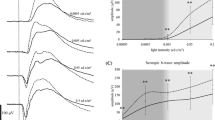Summary
-
1.
The electroretinograms and the intracellular potentials of receptor cells have been recorded from the divided eyes of Ascalaphus macaronius Scop. The relative spectral efficiency and sensitivity curves have been determined after a stimulation with monochromatic lights of equal quanta (from 315 to 625 nm).
-
2.
In ERG-measurements both parts of eyes show the same maximum of the spectral sensitivity in the UV-region of the spectrum at 350±20 nm; in the lateral eye, however, we have been able to establish one more secondary peak of sensitivity at 530±10 nm. The sensitivity of the lateral eye for the green light (530 nm) is approximately 1% of the maximal sensitivity at 350 nm. The frontal part of the eye is practically insensitive for wavelengths above 500 nm (Figs. 2 and 3).
-
3.
In the frontal eye the spectral efficiency was measured for 5 retinular cells, and in the lateral eye for one cell only. In all 6 cells the maximum of the sensitivity lies in the ultraviolet (Figs. 4 and 5). Greater responses could also be registered in one cell of the lateral eye with the light stimulation of 507 nm; nevertheless, we have not succeeded in measuring the spectral efficiency for this cell through the whole spectrum.
-
4.
The abilities thus determined for the eyes of the Ascalaphus macaronius Scop. have been compared with the data known for other arthropods. The author discusses also the biological significance of such selective UV-receptors.
Zusammenfassung
-
1.
An den Doppelaugen von Ascalaphus macaronius Scop. wurden das summarische ERG sowie die intrazellulär abgeleiteten Rezeptorpotentiale registriert. Nach Reizung mit monochromatischen quantengleichen Lichtern (von 315–625 nm) wurden die relativen spektralen Wirksamkeits- bzw. Empfindlichkeitskurven bestimmt.
-
2.
Beide Augenteile zeigen bei den ERG-Ableitungen ein gemeinsames Maximum der spektralen Empfindlichkeit im UV-Bereich bei 350±20 nm; im Lateralauge kann man jedoch noch einen Nebengipfel der Empfindlichkeit bei 530±10 nm feststellen. Die Empfindlichkeit des Lateralauges für grünes Licht (530 nm) beträgt ungefähr 1% der maximalen UV-Empfindlichkeit. Das Frontalauge ist für die Lichter oberhalb 500 nm praktisch unempfindlich (Abb. 2 und 3).
-
3.
Im Frontalauge wurde die spektrale Wirksamkeit an 5 Retinulazellen gemessen, im Lateralauge nur an einer Zelle. Bei allen sechs Zellen lag das Maximum der Empfindlichkeit im Ultraviolett (Abb. 4 und 5). Bei einer Zelle aus dem Lateralauge konnten größere Belichtungspotentiale auch bei der Reizung mit dem Lichtreiz von 507 nm registriert werden, es gelang aber nicht, bei dieser Zelle das ganze Spektrum durchzumessen.
-
4.
Die festgestellten Fähigkeiten der Ascalaphus-Augen werden mit den Daten für andere Arthropoden verglichen. Es wird auch die biologische Bedeutung solcher selektiven UV-Rezeptoren diskutiert.
Similar content being viewed by others
Literatur
Ast, F.: Über den feineren Bau der Facettenaugen bei Neuropteren. Zool. Jb. 41, 411–458 (1920).
Autrum, H.: Physiologie des Sehens. Fortschr. Zool. 13, 257–302 (1961).
—, u. V. v. Zwehl: Die spektrale Empfindlichkeit einzelner Sehzellen des Bienenauges. Z. vergl. Physiol. 48, 357–384 (1964).
Bennett, R. R.: Spectral sensitivity studies on the whirligig beetle, Dineutes ciliatus. J. Insect Physiol. 13, 621–633 (1967).
Burkhardt, D.: Lichtrezeptoren im Tierreich. Naturwissenschaften 50, 586–590 (1963).
—, u. H. Autrum: Die Belichtungspotentiale einzelner Sehzellen von Calliphora erythrocephala Meig. Z. Naturforsch. 15b, 612–616 (1960).
Frisch, K. v.: Tanzsprache und Orientierung der Bienen. Berlin-Heidelberg-New York: Springer 1965.
Gogala, M., u. Š. Michieli: Das Komplexauge von Ascalaphus, ein spezialisiertes Sinnesorgan für kurzwelliges Licht. Naturwissenschaften 52, 217–218 (1965).
Jockusch, B.: Bau und Funktion eines larvalen Insektenauges: Untersuchungen am Ameisenlöwen (Euroleon nostras Fourcroy, Planip., Myrmel.). Z. vergl. Physiol. 56, 171–198 (1967).
Mazokhin-Porshnyakov, G. A.: Colorimetric study of colour vision in the dragonfly (russ. mit engl. Zusammenf.). Biofizika 4, 427–436 (1959).
—: Das Sehen der Insekten (russ.) Moskva: Nauka 1965.
Michieli, S.: Spektraina občutljivost insektov. Razprave SAZU, IV. razred. 9, 207–251 (1966).
Ruck, P.: The components of the visual system of a dragonfly. J. gen. Physiol. 49, 289–307 (1965).
Author information
Authors and Affiliations
Additional information
Dem Andenken an Herrn Privatdozent Dr. Christian Hoffmann gewidmet.
Stipendiat der A. v. Humboldt-Stiftung im Jahre 1964/65.
Rights and permissions
About this article
Cite this article
Gogala, M. Die spektrale Empfindlichkeit der Doppelaugen von Ascalaphus macaronius Scop. (Neuroptera, Ascalaphidae). Z. Vergl. Physiol. 57, 232–243 (1967). https://doi.org/10.1007/BF00302998
Received:
Issue Date:
DOI: https://doi.org/10.1007/BF00302998




